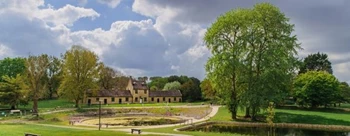Celebrating Great Linford's Historic Women
This International Women's Day (8th March) we are celebrating the stories of the women associated with Great Linford Manor Park over the centuries.
The Parks Trust has been awarded funding from the National Lottery Heritage Fund to 'Reveal, Revive and Restore' Great Linford Manor Park and to improve understanding of and appreciation for its rich heritage.
Frances Uthwatt (1728-1800)
The daughter of a Baron, Frances married Henry Uthwatt in 1750. Soon after their marriage, Henry inherited Great Linford Manor and the couple moved in. During the 18th century the estate was laid out as an English Landscape style pleasure garden and so Frances and Henry may have enjoyed long strolls in the Wilderness, taken tea in the Doric Seat and gazed out over the Ha-ha. Perhaps the gardens were already designed this way when they arrived. Perhaps the couple designed them themselves. We don't know because we don't have any dated plans.
Frances suffered much loss during her life: firstly with her brother taking his own life in 1755, then sadly Henry died of tuberculosis in 1757. Not long after Frances was engaged again, to Great Linford rector Lawson Shan, be he too died before they could wed. Nevertheless she remained a pillar of strength and continued to run the estate alone (under the gaze of trustees) for 30 years until her death in 1800. During her time she oversaw the cutting of the Grand Union Canal through the estate, much to the frustration of Henry Uthwatt Andrewes Uthwatt, who was next to inherit.

Perhaps Henry and Frances looked a bit like Mr and Mrs Andrews in Gainsborough's 1750 painting? Via Art UK, photograph © The National Gallery.
Click here to find out more about Frances Uthwatt (via Great Linford History website).
Jane Mills nee Mapley (1857- 1938)
In 1930 Jane Mills was living at the almshouses at Great Linford. In 1877 she had married George Mills and together they had ten children, and she was a skilled Bucks lace maker. This was a common job for working-class women in the late 19th and early 20th centuries as it paid better than roles in domestic service. Bucks lace was very popular with the aristocracy and royals; in fact Queen Victoria herself was a big fan. Sadly Jane's health deteriorated and she moved in with her daughter Maud Pool who lived at Station Terrace.
Kezia Rainbow (1866-1942)
Kezia (nee Roberts) was born in Newport Pagnell in 1866 but had moved to Great Linford by the 1911 census, where she was living in Shop Yard in the village with her mother Elizabeth. Kezia and her husband Kizby fell on hard times and by 1911 3 of their children and Kizby himself were inmates of Newport Pagnell workhouse. Thankfully, after a few years, Kizby and their children had made their way out of the workhouse and were in employment.
Kezia herself is recorded as a fiery personality, who had a number of altercations with the authorities between 1913 and 1921. After Kizby passed away in 1926, Kezia found a new home at the Great Linford Almshouses, where she would spend most of the rest of her life.
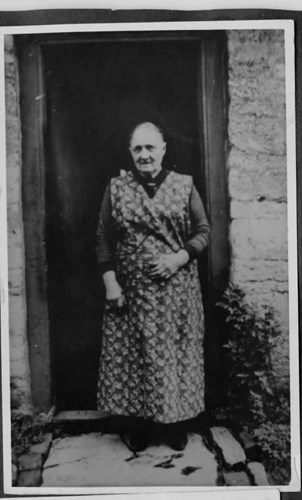

Top: Kezia Rainbow outside the almshouses, Bottom: Kezia's daughter Fanny outside the almshouses.
Click here to find out more about Kezia Rainbow (via Great Linford History website).
Stella Uthwatt (1910-1996)
Stella Andrewes Uthwatt was born in 1910, the daughter of Gerard Uthwatt and Gertrude F. Bouverie. She grew up at Great Linford but never married. In the 20th century censuses her occupation is listed as 'living on own means', implying she didn't need to work and lived off the family estate. From the early 1900s her family employed servants to look after them and the house, including a nurse called Annie (29), a cook called Florence (35) and a parlourmaid called Phyllis (25). When WWII broke out, Stella enrolled as a volunteer with the Women's Auxiliary Air Force. Her father Gerard died on the 12th July 1950, leaving her and her mother the sum of £700,000 (about £21m in today's money) and with this she continued to run the estate after the death of her mother, she even took over from her father as Master of the Otter Hounds. Also like her father she was elected to Newport Pagnell Rural District Council as the first woman councillor and representative for Great Linford and Stantonbury. Stella has been remembered by local residents as "prim and proper...sort of almost like a Victorian lady...people had to say 'Yes Milady' and 'No Milady'. She is also remembered as always wearing tweed with amber jewellery and carrying around a hunting rifle.
In 1964 Stella Uthwatt leased the Manor and grounds to Chilstone garden ornaments company. In 1972 it was sold to the Milton Keynes Development Corporation. She retired to Scotland where she died in 1996.

We believe Stella to be pictured on the far left at her cousin's wedding.
Click here to find out more about Stella Uthwatt (via Great Linford History website).
Mezilla Wilson (1847-1922)
Mezilla is the only documented school mistress of the Great Linford Manor almshouses. She is first noted as living in the school house in the census of 1871. It was unusual at the time to have a woman in her position; usually it would have been a male school master. Mezilla taught in the Dutch-gabled school house and lived in the accommodation upstairs. Female employment in the 1850s-70s appears to be higher than any recorded again until after WWII (BBC History 2011). Mezilla was just 23 when she was school mistress and lived with her sister Emma (16) and brother Joseph (6) in the census of 1871.
From records we know that when Mezilla was living at the school house, all but one of the almshouses were occupied, mostly by older people. State pensions were not introduced until 1908, and only those who inherited or accumulated wealth could afford to retire. Everyone else had to work until they physically couldn't anymore. Living in the other almshouses at the time were 5 female lacemakers. This is unsurprising as the textiles industry the second largest employer of women at the time after domestic service. Some Great Linford residents still recall lacemakers living and working in the almshouses in the 1940s and 50s.
In 1875 at age 27, Mezilla married Charles Henry Godfrey at Banbury in Oxfordshire. They had three children: Charles Henry, Minnie and Edith Ellen.
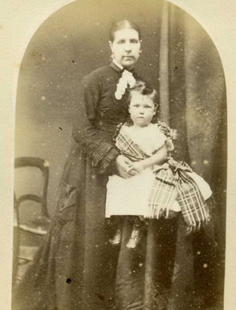
Mezilla Wilson pictured with her daughter.
Witches & Witchcraft
Dr. Napier's casebooks have been studied and digitised and a strong theme of witchcraft runs through them. Many patients came to him claiming they had been bewitched and blamed other people for causing their illnesses. It was quite common in the 17th century for sudden and unusual ailments to be blamed on witches, who we now know were just normal women who perhaps were unmarried or lived outside the social norm.
In one of Napier's cases he sees a patient called Rebecca Bony who visits from Dorset. He notes 'she fears witchery because she was a searcher of a witch that was hanged at Northampton', implying that women were accusing other women of witchcraft in a culture of hysteria. In another case, Miss Elisabeth Belcher visits Napier and he notes 'she was bewitched and the witches were hanged at Northampton'. We know that Miss Belcher's 'witch' was a woman called Agnes Brown, who was hanged at the Northampton Witch Trials on the 22nd July 1612 in Abingdon Gallows. The story, published in a contemporary pamphlet, goes that Miss Belcher was in a fit of rage and struck Agnes' daughter, Joane, causing her to leave her company. Promising her revenge on Miss Belcher, Joane returns home to her mother Agnes and tells her of the attack. Four nights later while Miss Belcher slept, she experienced "a gripping and gnawing in her body". She immediately blamed Joane. Agnes and Joane were both apprehended for their crimes, pleading not guilty of the bewitchment of Miss Belcher. Despite their pleas, they were found guilty and executed at the Witch Trials in 1612.
A sad story, this sort of accusatory behaviour was common across England at the time. What is ironic is that Napier was practising as what we would probably call today a witchdoctor! He was treating all classes of society with strange and spooky things like 'applying dead pigeons to the feet as slippers' and 'toad bones powdered in cardus water'. Fortunately we know a lot more about medicines now and doctors don't study the stars or consult with angels to know what to do, and we no longer blame ordinary women for bewitching us into illnesses!
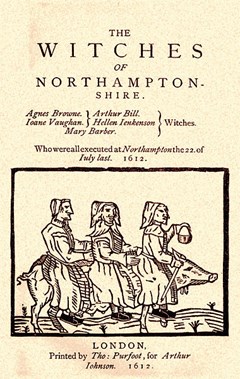
Cover of the pamphlet 'The Witches of Northampton' 1612 (Arthur Johnson)
Alice & Magdalen Egerton
Dr. Richard Napier was a medical man who used astrology and 'consultations with angels' to write prescriptions for his patients who called at his residence at the Old Rectory in Great Linford Manor Park. Many women came to visit Napier about a variety of ailments, but two of the most notable were Alice and Magdalen Egerton, the daughters of John and Frances Egerton, the Earl and Countess of Bridgewater, who visited Napier from 1632-3. Alice had 'suffocation of the mother (womb)' where toxic fluids caused convulsions, whilst Magdalen had ulcerous swellings on her neck.
For both women, Napier prescribed medicines which they took orally through pills, by scent therapy or through the skin with an ointment. They also had their blood sucked by leeches! Napier thought that excess 'humours' were the cause of most diseases and that these could be released through the blood, pus, stools and vomit. Another of his mad theories was that Magdalen's ulcers could be cured with a coin blessed by the king! At the time, many illnesses were blamed on witchcraft, and Alice's father worried she had been bewitched. Napier prescribed her a ring, pomander and a pendant inscribed with magical symbols.
Much of Alice and Magdalen's treatment was conducted from afar. He wrote treatments in his letters as their family estate was at Ashridge in Kent. It appears the Egertons were fans of astrological medicine as they sought his advice over such a vast distance. What's more the family's papers included a nativity (birth horoscope) for Lady Alice that predicted her medical future...
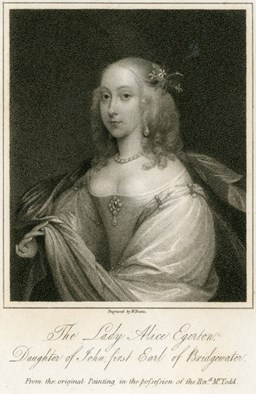
Lady Alice Egerton (from Casebooks Project, © Fairclough Collection, University of Leicester)Click here to read more about the Rev. Dr. Richard Napier. (This link will take you to the Great Linford History website).




